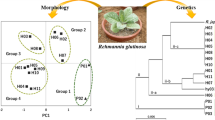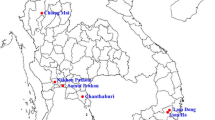Abstract
Coptis japonica is widely distributed in Japan, and its dried rhizome is a source of the domestic herbal medicine Coptidis Rhizoma (黄連 Oren). There are three varieties of C. japonica, two of which, namely, C. japonica var. anemonifolia and C. japonica var. major, are important as sources of traditional medicines. Coptis japonica var. anemonifolia and C. japonica var. major are distinguishable on the basis of their ternate or biternate compound leaves, respectively. In the Hokuriku area, where both C. japonica var. anemonifolia and C. japonica var. major grow naturally, some individual plants cannot be identified unambiguously on the basis of leaf morphology because changes in leaf morphology may occur due to intra-variety variation or crossbreeding between the two varieties. In addition, genetic differences between the two varieties have remained unclear. In this study, we employed new genetic and morphological classification approaches to discriminate between the two varieties. Based on the single nucleotide polymorphisms of the tetrahydroberberine oxidase gene, we found four conserved SNPs between the two varieties and were able to classify C. japonica into two varieties and crossbreeds. Furthermore, we introduced a new leaf type index based on the overall degree of leaflet dissection calculated by surface area of a leaflet and length of leaflet margin and petiolule. Using our new index we were able to discriminate between the two varieties and their crossbreeds more accurately than is possible with the conventional discrimination method. Our genetic and morphological classification methods may be used as novel benchmarks to discriminate between the two varieties and their crossbreeds.






Similar content being viewed by others
References
The Ministry of Health, Labour and Welfare (2016) The Japanese pharmacopoeia. 17th edn (English version). The Ministry of Health, Labour and Welfare, Tokyo
Mikage M, Kawamoto M (1998) Herbological studies of Coptidis Rhizoma (1). On the reason why “Kaga-Oren” was estimated as of high quality in the Edo era. Nat Med 52(5):414–420
Satake Y (1949) A note on the Coptis of Japan. J Jpn Bot 24:69–74
Iwatsuki K, Boufford DE, Ohba H (2006) Flora of Japan. Kodansha, Tokyo,
Konishi T, Kiyosawa S, Shimada Y, Terakado S, Hosoido S (1998) Vegetation on some colonies of Coptis japonica in Makino-cho, Takashimagun, Pref. Shiga. Nat Med 52(4):375–383
Xiang KL, Wu SD, Yu SX, Liu Y, Jabbour F, Erst AS, Zhao L, Wang W, Chen ZD (2016) The first comprehensive phylogeny of Coptis (Ranunculaceae) and its implications for character evolution and classification. PLoS One 11:e0153127
Corrado G, Piffanelli P, Caramante M, Coppola M, Rao R (2013) SNP genotyping reveals genetic diversity between cultivated landraces and contemporary varieties of tomato. BMC Genomics 14:835
Mitsui Y, Setoguchi H (2012) Demographic histories of adaptively diverged riparian and non-riparian species of Ainsliaea (Asteraceae) inferred from coalescent analyses using multiple nuclear loci. BMC Evol Biol 12:254
Okada N, Shinmyo A, Okada H, Yamada Y (1998) Purification and characterization of (S)-tetrahydroberberine oxidase from cultured Coptis japonica cells. Phytochemistry 27:979–982
Matsushima Y, Minami H, Hori K, Sato F (2012) Pathway engineering of benzylisoquinoline alkaloid biosynthesis in transgenic California poppy cells with ectopic expression of tetrahydroberberine oxidase from Coptis japonica. Plant Biotechnol 29:473–481
Kojoma M, Seki H, Yoshida S, Muranaka T (2006) DNA polymorphisms in the tetrahydrocannabinolic acid (THCA) synthase gene in “drug-type” and “fiber-type” Cannabis sativa L. Forensic Sci Int 159:132–140
Tamura K, Stecher G, Peterson D, Filipski A, Kumar S (2013) MEGA6: molecular evolutionary genetics analysis version 6.0. Molec Biol Evol 30(12):2725–2729
Salgado-Salazar C, Rossman AY, Chaverri P (2013) Not as ubiquitous as we thought: taxonomic crypsis, hidden diversity and cryptic speciation in the cosmopolitan fungus Thelonectria discophora (Nectriaceae, Hypocreales, Ascomycota). PLoS One 8:e76737
Sing T, Sander O, Beerenwinkel N, Lengauer T (2005) ROCR: visualizing classifier performance in R. Bioinformatics 21:3940–3941
Robin X, Turck N, Hainard A, Tiberti N, Lisacek F, Sanchez JC, Müller M (2011) pROC: an open-source package for R and S + to analyze and compare ROC curves. BMC Bioinform 12:77
Wang XM, Hou XQ, Zhang YQ, Li Y (2014) Morphological variation in leaf dissection of Rheum palmatum complex (Polygonaceae). PLoS One 9:e110760
Jian H, Yang B, Zhang A, Zhang L, Xu X, Li J, Liu L (2017) Screening of candidate leaf morphology genes by integration of QTL mapping and RNA sequencing technologies in Oilseed Rape (Brassica napus L.). PLoS One 12:e0169641
Viscosi V, Cardini A (2011) Leaf morphology, taxonomy and geometric morphometrics: a simplified protocol for beginners. PLoS One 6:e25630
Li X, Li Y, Zhang Z, Li X (2015) Influences of environmental factors on leaf morphology of Chinese jujubes. PLoS One 10:e0127825
Xu F, Guo W, Xu W, Wei Y, Wang R (2009) Leaf morphology correlates with water and light availability: what consequences for simple and compound leaves? Prog Nat Sci 19:1789–1798
Acknowledgements
We are grateful to Ms. Kazumi Fukuhara, Mr. Naomi Kuwahata, and Mr. Yoshiaki Kato for kindly providing samples of C. japonica. We also thank Dr. Kozo Fukuda for providing useful information.
Author information
Authors and Affiliations
Corresponding author
Ethics declarations
Conflict of interest
The authors declare no conflict of interest.
Electronic supplementary material
Below is the link to the electronic supplementary material.
Rights and permissions
About this article
Cite this article
Kitamura, M., Ando, H. & Sasaki, Y. Morphological and genetic differences between Coptis japonica var. anemonifolia H. Ohba and Coptis japonica var. major Satake in Hokuriku area. J Nat Med 72, 514–522 (2018). https://doi.org/10.1007/s11418-018-1179-9
Received:
Accepted:
Published:
Issue Date:
DOI: https://doi.org/10.1007/s11418-018-1179-9




